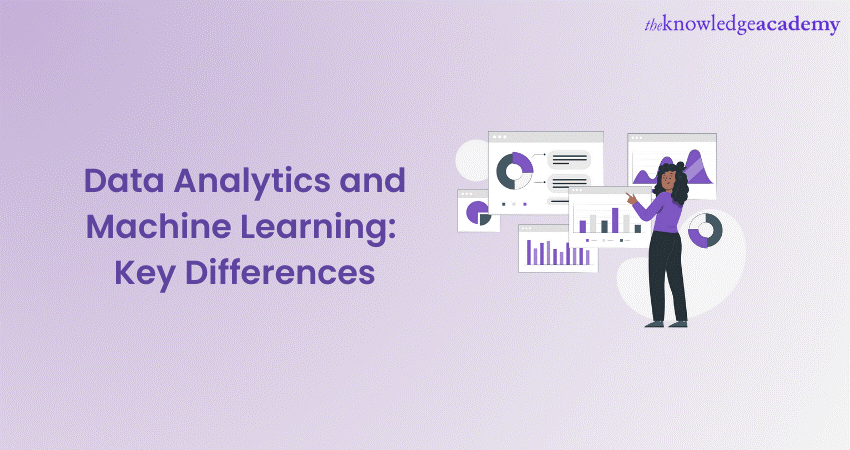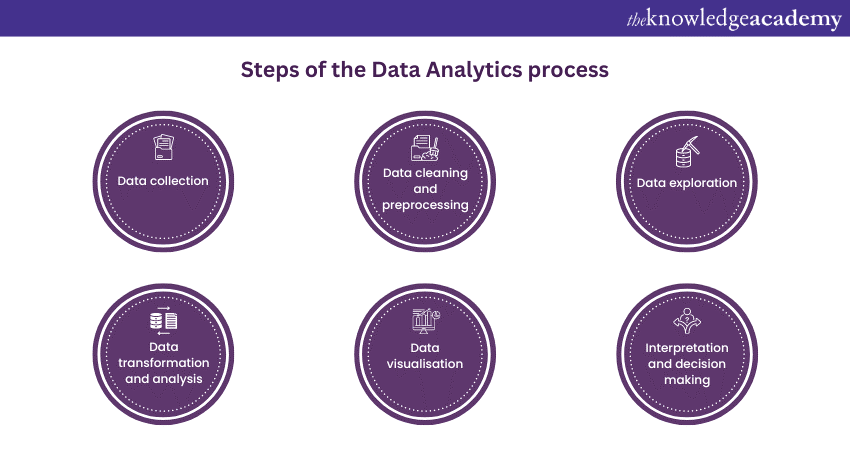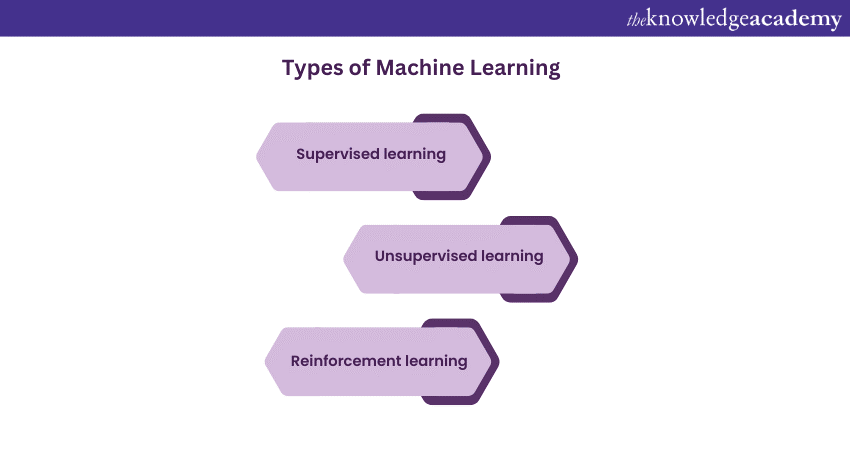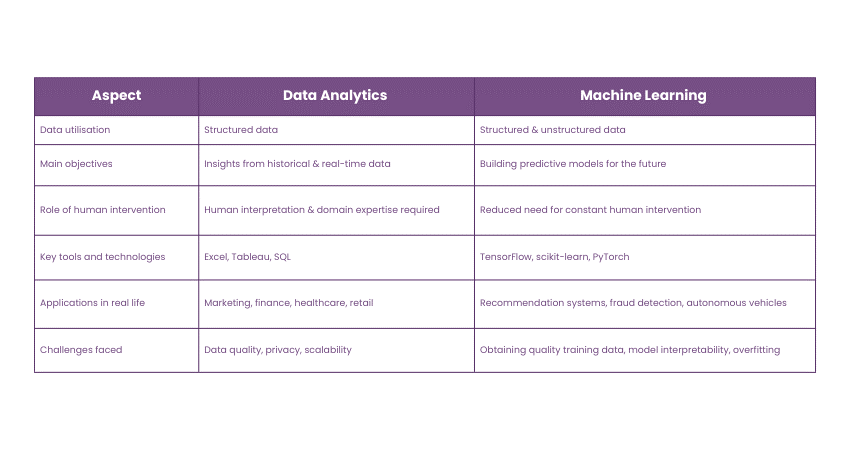We may not have the course you’re looking for. If you enquire or give us a call on 01344203999 and speak to our training experts, we may still be able to help with your training requirements.
Training Outcomes Within Your Budget!
We ensure quality, budget-alignment, and timely delivery by our expert instructors.

Data Analytics and Machine Learning both play crucial roles in the domain of Data Science, but they have distinct approaches, goals, and applications. Understanding these differences is essential for anyone seeking to dive into the fascinating world of data-driven insights and intelligent algorithms. In this blog, we will explore the fundamental difference between Data Analytics and Machine Learning and expand further on why and how the two differ.
Table of Contents
1) What is Data Analytics?
2) What is Machine Learning?
3) Data Analytics and Machine Learning: What are the differences?
a) Data utilisation
b) Main objectives
c) Role of human intervention
d) Key tools and technologies
e) Applications in real life
f) Challenges faced
4) Conclusion
What is Data Analytics?
Data Analytics, a vital discipline in the domain of Data Science, revolves around the exploration, examination, and interpretation of vast datasets to glean valuable insights and meaningful patterns. It is a process of converting raw data into actionable information, enabling businesses and organisations to make informed decisions and drive growth.
At its core, Data Analytics involves the use of statistical and mathematical techniques to dissect data and uncover trends, relationships, and correlations. These analyses help businesses gain a comprehensive understanding of their operations, customer behaviour, market trends, and much more. By harnessing the true power of Data Analytics, businesses can optimise processes, enhance performance, and stay ahead in the modern data-driven world.
The Data Analytics process can be broken down into several key steps:

a) Data collection: The first step in Data Analytics involves gathering data from various sources. This data can be structured (e.g., databases, spreadsheets) or unstructured (e.g., text, images, audio), and it may originate from internal systems, customer interactions, social media, or external databases.
b) Data cleaning and preprocessing: Raw data often contains errors, missing values, and inconsistencies. Analysts clean and preprocess the data, removing irrelevant information, handling missing values, and standardising the format to ensure accuracy and consistency.
c) Data exploration: Once the data is prepared, analysts perform Exploratory Data Analysis (EDA) to understand its characteristics better. This involves using charts, graphs, and descriptive statistics to visualise the data and identify initial patterns.
d) Data transformation and analysis: In this step, analysts apply various statistical and mathematical techniques to extract meaningful insights from the data. Techniques such as regression, clustering, and classification are commonly used to uncover relationships and trends.
e) Data visualisation: Data visualisation is a critical aspect of Data Analytics. Presenting data in visual formats, such as charts, graphs, and dashboards, enhances the comprehension of complex information and allows decision-makers to grasp insights quickly.
f) Interpretation and decision-making: Analysts interpret the results of their analyses, drawing actionable conclusions that can guide decision-making. These insights are shared with stakeholders to inform business strategies and drive improvements.
Supercharge your data skills with our Big Data and Analytics Training. Register now!
What is Machine Learning?
Machine Learning, known as a subset of Artificial Intelligence (AI), is a cutting-edge field that empowers computer systems to learn from data and enhance their performance over time without being explicitly programmed. Inspired by the learning process of the human brain, Machine Learning algorithms allow computers to recognise patterns, make predictions, and make decisions autonomously.
The core concept of Machine Learning lies in its ability to identify and learn from patterns within datasets. The process begins with training the Machine Learning model on a vast amount of labelled data, where the desired outcomes are already known. During the training phase, the model iteratively adjusts its internal parameters to minimise errors and improve accuracy in making projections.
Once the model has been trained, it can be used with new, unseen data to make informed decisions or generate predictions. As it encounters more data, the model continues to adapt and refine its predictions, making it increasingly proficient over time. Machine Learning can be broadly categorised into three main types:

a) Supervised learning: In supervised learning, the model is trained on labelled data, where both input and corresponding output are provided. The algorithm learns to map inputs to the correct outputs, allowing it to make predictions on new, unseen data accurately. Common applications of supervised learning include image classification, sentiment analysis, and regression tasks.
b) Unsupervised learning: Unsupervised learning involves training the model on unlabelled data, and the algorithm tries to find hidden patterns or structures within the data. It identifies clusters and groups similar data points together based on their attributes. Clustering and dimensionality reduction are typical applications of unsupervised learning.
c) Reinforcement learning: Reinforcement learning is a unique form of Machine Learning that the model acquires by interacting with a specific environment and receiving feedback in the form of rewards or penalties. The algorithm aims to maximise the total reward it receives over time, making it suitable for tasks involving decision-making in dynamic environments.
Want to unlock the power of Big Data Analysis? Join our Big Data Analysis Course today!
Data Analytics and Machine Learning: What are the differences?
Now that we know what Data Analytics and Machine Learning are, we will look into a detailed comparison of Data Analytics vs Machine Learning. This blog section will expand on the difference between Data Analytics and Machine Learning below.

Data utilisation
Data Analytics primarily deals with structured data, which is organised in a tabular format, such as databases and spreadsheets. It involves the extraction of valuable insights and patterns from historical and real-time data. Analysts use statistical and mathematical techniques to identify trends, correlations, and anomalies within the data. The emphasis is on understanding past performance and optimising processes based on historical data.
Machine Learning, on the other hand, can handle both structured and unstructured data. In addition to tabular data, it can process textual, image, and audio data. Machine Learning algorithms learn from the data provided to them, making predictions or decisions based on new and unseen data. Unlike Data Analytics, Machine Learning focuses on creating models that can autonomously learn and improve over time.
Main objectives
The main objective of Data Analytics is to gain insights into historical and current data. It aims to answer specific business questions and uncover patterns that can help organisations make informed decisions. Data Analytics plays a vital role in identifying areas for improvement, optimising processes, and enhancing overall efficiency.
Machine Learning's primary objective is to build predictive models that can make accurate forecasts or decisions based on new data. The focus is on enabling systems to learn and improve from experience without explicit programming. Machine Learning is forward-looking and strives to make accurate predictions about future events.
Role of human intervention
In Data Analytics, human intervention is essential throughout the entire process. Data analysts interpret the results, draw meaningful conclusions, and provide insights to decision-makers. Domain expertise is crucial in understanding the context of the data and making informed judgments.
Machine Learning models can learn autonomously from data, reducing the need for constant human intervention. Once the models are trained, they can make predictions or decisions without human involvement. However, human oversight remains important to ensure the models are ethical, unbiased, and aligned with business goals.
Want to take your Data Science skills to the next level? Join our Big Data Analytics & Data Science Integration Course now!
Key tools and technologies
Data Analytics commonly utilises tools such as Microsoft Excel, Tableau, Power BI, and SQL for data manipulation, visualisation, and analysis. These tools provide a user-friendly interface for data exploration and reporting.
Machine Learning relies on various libraries and frameworks that facilitate the development and training of models. Popular Machine Learning libraries include TensorFlow, Scikit-learn, PyTorch, and Keras. These libraries offer a wide variety of algorithms and functionalities for model building and evaluation.
Applications in real life
Data Analytics finds applications in a wide array of industries, including marketing, finance, healthcare, retail, and supply chain management. For instance, in marketing, Data Analytics helps businesses understand customer preferences, optimise marketing campaigns, and improve customer targeting.
Machine Learning powers numerous real-life applications, such as recommendation systems in e-commerce, fraud detection in finance, personalised healthcare, and autonomous vehicles. For example, in autonomous vehicles, Machine Learning algorithms process sensor data to make real-time decisions on driving and navigation.
Challenges faced
Some challenges faced in Data Analytics include ensuring data quality and integration from disparate sources. Privacy and security concerns also arise when handling sensitive data. Additionally, scaling analytical tools to handle large datasets can be a significant challenge.
In Machine Learning, obtaining quality training data can be a substantial obstacle. The interpretability and explainability of complex Machine Learning models remain challenging, especially in critical domains like healthcare and finance. Moreover, overfitting and generalisation issues can impact the performance of Machine Learning models.

Conclusion
All in all, both Machine Learning and Data Analytics are two vital pillars of Data Science, with each serving distinct purposes. Data Analytics helps us understand the past and present, while Machine Learning enables us to predict and make decisions about the future. Understanding the difference between Data Analytics and Machine Learning is essential for organisations to harness the best insights. As businesses and industries continue to harness the power of data, both fields will play an increasingly integral role in shaping our data-driven world.
Unlock the power of data with our comprehensive Data Science & Analytics Training. Sign up now!
Frequently Asked Questions
Upcoming Data, Analytics & AI Resources Batches & Dates
Date
 Hadoop Big Data Certification
Hadoop Big Data Certification
Thu 12th Sep 2024
Thu 12th Dec 2024







 Top Rated Course
Top Rated Course


 If you wish to make any changes to your course, please
If you wish to make any changes to your course, please


